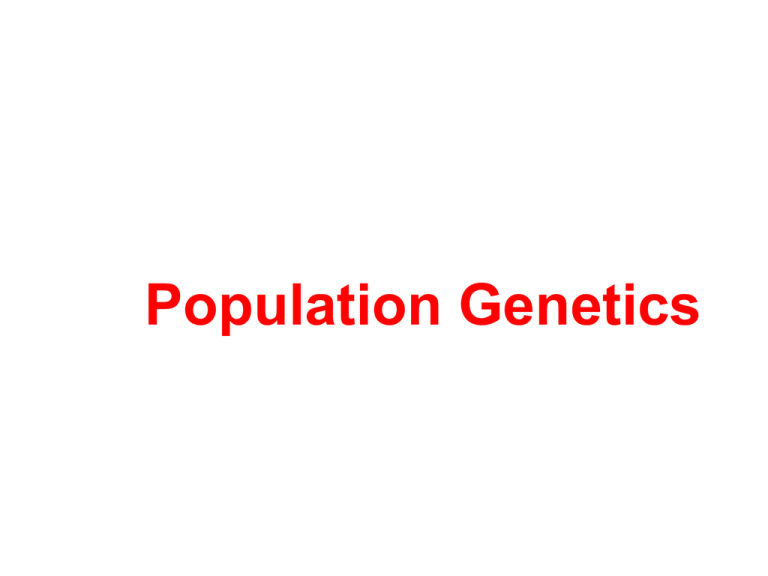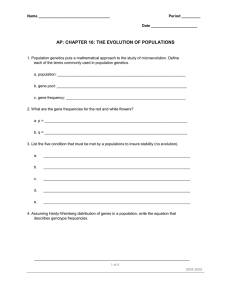Question
advertisement

Population Genetics Population Genetics The study of genetic variation in populations. Population A localized group of individuals of the same species. Species A group of similar organisms. A group of populations that could interbreed. Gene Pool The total aggregate of genes in a population. If evolution is occurring, then changes must occur in the gene pool of the population over time. Microevolution Changes in the relative frequencies of alleles in the gene pool. Hardy-Weinberg Theorem Developed in 1908. Mathematical model of gene pool changes over time. Basic Equation p +q=1 p = % dominant allele q = % recessive allele Expanded Equation p +q=1 (p + q)2 = (1)2 p2 + 2pq + q2 = 1 Genotypes p2 = Homozygous Dominants 2pq = Heterozygous q2 = Homozygous Recessives Example Calculation Let’s look at a population where: A = red flowers a = white flowers Starting Population N = 500 Red = 480 (320 AA+ 160 Aa) White = 20 Total Genes = 2 x 500 = 1000 Dominant Allele A = (320 x 2) + (160 x 1) = 800 = 800/1000 A = 80% Recessive Allele a = (160 x 1) + (20 x 2) = 200/1000 = .20 a = 20% A and a in HW equation Cross: Aa X Aa Result = AA + 2Aa + aa Remember: A = p, a = q Substitute the values for A and a p2 + 2pq + q2 = 1 (.8)2 + 2(.8)(.2) + (.2)2 = 1 .64 + .32 + .04 = 1 Dominant Allele A = p2 + pq = .64 + .16 = .80 = 80% Recessive Allele a = pq + q2 = .16 + .04 = .20 = 20% Result Gene pool is in a state of equilibrium and has not changed because of sexual reproduction. No Evolution has occurred. Importance of Hardy-Weinberg Yardstick to measure rates of evolution. Predicts that gene frequencies should NOT change over time as long as the HW assumptions hold. Way to calculate gene frequencies through time. Example What is the frequency of the PKU allele? PKU is expressed only if the individual is homozygous recessive (aa). PKU Frequency PKU is found at the rate of 1/10,000 births. PKU = aa = q2 q2 = .0001 q = .01 Dominant Allele p +q=1 p = 1- q p = 1- .01 p = .99 Expanded Equation p2 + 2pq + q2 = 1 (.99)2 + 2(.99x.01) + (.01)2 = 1 .9801 + .0198 + .0001 = 1 Final Results Normals (AA) = 98.01% Carriers (Aa) = 1.98% PKU (aa) = .01% AP Problems Using Hardy-Weinberg for q2 (% of total). Solve for q (equation). Solve for p (1- q). H-W is always on the national AP Bio exam (but no calculators are allowed). Solve Hardy-Weinberg Assumptions 1. Large Population 2. Isolation 3. No Net Mutations 4. Random Mating 5. No Natural Selection If H-W assumptions hold true: The gene frequencies will not change over time. Evolution will not occur. But, how likely will natural populations hold to the H-W assumptions? Microevolution Caused by violations of the 5 H-W assumptions. Causes of Microevolution 1. Genetic Drift 2. Gene Flow 3. Mutations 4. Nonrandom Mating 5. Natural Selection Genetic Drift Changes in the gene pool of a small population by chance. Types: 1. Bottleneck Effect 2. Founder's Effect By Chance Bottleneck Effect Loss of most of the population by disasters. Surviving population may have a different gene pool than the original population. Result Some alleles lost. Other alleles are overrepresented. Genetic variation usually lost. Importance Reduction of population size may reduce gene pool for evolution to work with. Ex: Cheetahs Founder's Effect Genetic drift in a new colony that separates from a parent population. Ex: Old-Order Amish Result Genetic variation reduced. Some alleles increase in frequency while others are lost (as compared to the parent population). Importance Very common in islands and other groups that don't interbreed. Gene Flow Movement of genes in/out of a population. Ex: Immigration Emigration Result Changes in gene frequencies. Mutations Inherited changes in a gene. Result May change gene frequencies (small population). Source of new alleles for selection. Often lost by genetic drift. Nonrandom Mating Failure to choose mates at random from the population. Causes Inbreeding within the same “neighborhood”. Assortative mating (like with like). Result Increases the number of homozygous loci. Does not in itself alter the overall gene frequencies in the population. Natural Selection Differential success in survival and reproduction. Result - Shifts in gene frequencies. Comment As the Environment changes, so does Natural Selection and Gene Frequencies. Result If the environment is "patchy", the population may have many different local populations. Genetic Basis of Variation 1. Discrete Characters – Mendelian traits with clear phenotypes. 2. Quantitative Characters – Multigene traits with overlapping phenotypes. Polymorphism The existence of several contrasting forms of the species in a population. Usually inherited as Discrete Characteristics. Examples Garter Snakes Gaillardia Human Example ABO Blood Groups Morphs = A, B, AB, O Other examples Quantitative Characters Allow continuous variation in the population. Result – Geographical Variation Clines: a change along a geographical axis Yarrow and Altitude Sources of Genetic Variation Mutations. Recombination though sexual reproduction. Crossing-over Random fertilization Preserving Genetic Variation 1. Diploidy - preserves recessives as heterozygotes. 2. Balanced Polymorphisms preservation of diversity by natural selection. Example Heterozygote Advantage When the heterozygote or hybrid survives better than the homozygotes. Also called Hybrid vigor. Result Can't bred "true“ and the diversity of the population is maintained. Ex – Sickle Cell Anemia Comment Population geneticists believe that ALL genes that persist in a population must have had a selective advantage at one time. Ex – Sickle Cell and Malaria, Tay-Sachs and Tuberculosis Fitness - Darwinian The relative contribution an individual makes to the gene pool of the next generation. Relative Fitness Contribution of one genotype to the next generation compared to other genotypes. Rate of Selection Differs between dominant and recessive alleles. Selection pressure by the environment. Modes of Natural Selection 1. Stabilizing 2. Directional 3. Diversifying 4. Sexual Stabilizing Selection toward the average and against the extremes. Ex: birth weight in humans Directional Selection Selection toward one extreme. Ex: running speeds in race animals. Ex. Galapagos Finch beak size and food source. Diversifying Selection toward both extremes and against the norm. Ex: bill size in birds Comment Diversifying Selection - can split a species into several new species if it continues for a long enough period of time and the populations don’t interbreed. Sexual Mate selection May not be adaptive to the environment, but increases reproduction success of the individual. Result Sexual dimorphism. Secondary sexual features for attracting mates. Comments Females may drive sexual selection and dimorphism since they often "choose" the mate. The Origin of Species Biological Species A group of organisms that could interbreed in nature and produce fertile offspring. Key Points Could interbreed. Fertile offspring. Speciation Requires: 1. Variation in the population. 2. Selection. 3. Isolation. Reproductive Barriers Serve to isolate a populations from other gene pools. Create and maintain “species”. Modes of Speciation 1. Allopatric Speciation 2. Sympatric Speciation Both work through a block of gene flow between two populations. Allopatric Speciation Allopatric = other homeland Ancestral population split by a geographical feature. Comment – the size of the geographical feature may be very large or small. Example Pupfish populations in Death Valley. Generally happens when a specie’s range shrinks for some reason. Another Example Conditions Favoring Allopatric Speciation 1. Founder's Effect - with the peripheral isolate. 2. Genetic Drift – gives the isolate population variation as compared to the original population. Conditions Favoring Allopatric Speciation 3. Selection pressure on the isolate differs from the parent population. Result Gene pool of isolate changes from the parent population. New Species can form. Comment Populations separated by geographical barriers may not evolve much. Ex - Pacific and Atlantic Ocean populations separated by the Panama Isthmus. Examples Fish - 72 identical kinds. Crabs - 25 identical kinds. Echinoderms - 25 identical kinds. Adaptive Radiation Rapid emergence of several species from a common ancestor. Common in island and mountain top populations or other “empty” environments. Ex – Galapagos Finches Mechanism Resources are temporarily infinite. Most offspring survive. Result - little Natural Selection and the gene pool can become very diverse. When the Environment Saturates Natural Selection resumes. New species form rapidly if isolation mechanisms work. Sympatric Speciation Sympatric = same homeland New species arise within the range of parent populations. Can occur In a single generation. Plants Polyploids may cause new species because the change in chromosome number creates postzygotic barriers. Polyploid Types 1. Autopolyploid - when a species doubles its chromosome number from 2N to 4N. 2. Allopolyploid - formed as a polyploid hybrid between two species. Ex: wheat Autopolyploid Allopolyploid Animals Don't form polyploids and will use other mechanisms. Gradualism Evolution Darwinian style evolution. Small gradual changes over long periods time. Gradualism Predicts: Long periods of time are needed for evolution. Fossils should show continuous links. Problem Gradualism doesn’t fit the fossil record very well. (too many “gaps”). Punctuated Evolution New theory on the “pacing” of evolution. Elridge and Gould – 1972. Punctuated Equilibrium Evolution has two speeds of change: Gradualism or slow change Rapid bursts of speciation Predictions Speciation can occur over a very short period of time (1 to 1000 generations). Fossil record will have gaps or missing links. Predictions New species will appear in the fossil record without connecting links or intermediate forms. Established species will show gradual changes over long periods of time. Possible Mechanism Adaptive Radiation, especially after mass extinction events allow new species to originate. Saturated environments favor gradual changes in the current species. Comment Punctuated Equilibrium is the newest ”Evolution Theory”. Best explanation of fossil record evidence to date. Evolutionary Trends Evolution is not goal oriented. It does not produce “perfect” species. Future of Evolution ? Look for new theories and ideas to be developed, especially from new fossil finds and from molecular (DNA) evidence.







